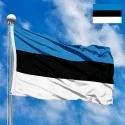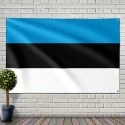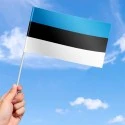The national flag of Estonia, known affectionately by Estonians as "Sinimustvalge" (blue-black-white), is a powerful and evocative symbol of the nation's identity, history, and aspirations. Its seemingly simple design, consisting of three horizontal stripes of equal width – blue at the top, black in the middle, and white at the bottom – belies a profound depth of meaning and a rich narrative woven into the fabric of Estonian culture. This flag is not merely a national emblem; it is a testament to the resilience of a people who have endured centuries of foreign rule, constantly striving for self-determination and a brighter future.
The dimensions of the Estonian flag are typically set at a ratio of 7:11 (height to width), with a standard size of 105 x 165 cm. This precise proportionality is legally defined to ensure consistency and proper representation of the national symbol. The colors themselves are specific: the blue is officially designated as Pantone 285C, a vibrant shade that evokes the vastness of the Estonian sky and the country's numerous lakes and coastal waters. Black, a deep, solid hue, represents the fertile soil of the homeland and, more profoundly, the historical struggles and sacrifices of the Estonian people. White, bright and pure, symbolizes hope, enlightenment, purity, and the promise of a prosperous future, also reminiscent of Estonia's snow-covered landscapes in winter and the light of its summer nights.
The history of the Estonian flag is deeply intertwined with the nation's awakening and its journey towards independence. The blue-black-white combination first emerged in the late 19th century as a symbol of the Estonian student movement. On June 4, 1884, the flag was consecrated at Otepää as the banner of the Estonian University Student Association "Vironia." This event marked a pivotal moment, as the flag quickly transcended its student origins to become a powerful national symbol for a people yearning for self-governance. The initial interpretations of the colors, established by "Vironia," laid the groundwork for their enduring significance: blue for the sky, lakes, and sea, symbolizing fidelity to national ideals; black for the native soil and the hardships endured; and white for the pursuit of happiness and light.
As the 20th century unfolded and the Russian Empire began to crumble, the blue-black-white flag gained increasing prominence. In early 1917, amidst growing calls for autonomy, Estonian political leaders officially declared these colors to be the national colors. The ultimate moment of official recognition came on February 23, 1918, when Estonia declared its full independence. The blue-black-white flag was ceremoniously hoisted, becoming the official flag of the newly formed republic. This act solidified its status as the supreme emblem of Estonian sovereignty. The "Law on State Flag" was formally adopted by the Riigikogu (Parliament) on June 27, 1922, legally codifying its design and usage.
However, the flag's journey was not without tribulation. With the Soviet occupation of Estonia in June 1940, the national flag was brutally suppressed. It was taken down from its most symbolic location, the Pikk Hermann tower in Tallinn, on June 21, 1940, even while Estonia was still formally independent. For nearly half a century under Soviet rule, the display of the blue-black-white flag was forbidden, becoming an act of profound defiance and a secret symbol of resistance. Its blue, specifically defined as "cornflower blue," even led to the cornflower itself becoming an unofficial symbol of resistance, prompting Soviet authorities to ban its representations. This period of suppression only deepened the flag's significance for the Estonian people, transforming it into a beacon of hope and a silent promise of future freedom.
The re-emergence of the flag in the late 1980s, during the Singing Revolution and the twilight of the Soviet Union, was a powerful visual manifestation of Estonia's renewed drive for independence. On August 7, 1990, the blue-black-white flag was officially reinstated as the national flag, fluttering once again from the Pikk Hermann tower, signaling the restoration of Estonian sovereignty. This moment was met with widespread jubilation and tears, marking the triumphant return of a cherished national symbol after decades of enforced absence.
For the inhabitants of Estonia, the flag holds an incredibly deep and personal meaning. It is not merely a piece of cloth; it embodies the collective memory of a nation, its struggles, its triumphs, and its enduring spirit. The blue represents their connection to the vast sky and the sea, which has shaped their livelihoods and cultural identity. It signifies fidelity, loyalty, and their profound bond with their homeland. The black speaks to the resilience and tenacity of the Estonian people, who have overcome centuries of oppression, foreign domination, and immense suffering. It is a reminder of their ancestors' hard work on the fertile, dark soil and the somber periods of their history, including the occupations and deportations. The white, in contrast, represents the hope for a brighter future, the pursuit of enlightenment and virtue, and the purity of their national aspirations. It also evokes the serene, snow-covered landscapes of Estonia in winter, a symbol of peace and untouched beauty, as well as the unique, luminous white nights of the Estonian summer.
Beyond these traditional interpretations, the flag serves as a constant reminder of freedom and independence, hard-won and fiercely protected. It represents unity among Estonians, a shared heritage, and a common destiny. The flag is proudly displayed on national holidays, at sporting events, and in homes across the country, serving as a powerful visual affirmation of national pride and solidarity. It is a symbol that resonates deeply with every Estonian, embodying their collective journey from oppression to liberation, and their unwavering commitment to their national identity.
Interesting facts about the Estonian flag further enrich its story. The specific shade of blue, Pantone 285C, is a careful choice, often described as "cornflower blue," due to the cornflower's significance as a national flower and its connection to resistance during Soviet times. The flag's design is deceptively simple, yet its tricolor arrangement is a classic representation of nationhood, shared by many countries but imbued with a unique Estonian narrative. The annual Flag Day on June 4th commemorates the consecration of the original student flag in 1884, highlighting the grassroots origins of this national symbol. Furthermore, the flag's temporary acceptance during the German occupation from 1941 to 1944, not as a national flag but as a symbol of ethnic Estonians, underscores its enduring cultural significance even amidst turbulent political shifts. The immediate re-hoisting of the flag in September 1944 after the German withdrawal, only to be replaced by the Soviet flag shortly after, dramatically illustrates the flag's role as a barometer of Estonian sovereignty throughout the tumultuous 20th century. The unwavering loyalty of Estonians to their flag, even when it was forbidden, speaks volumes about its profound psychological and emotional impact, making it a truly powerful emblem of national resilience and hope.
In the demonstration images, full-size flags are shown with proportions of 2:3, and hand-held flags with proportions of 1:2.






 Waving flag
Waving flag
 Sizes:
Sizes:
 Round flag
Round flag
 Sizes:
Sizes:
 Rectangular flag 2:3
Rectangular flag 2:3
 Sizes:
Sizes: